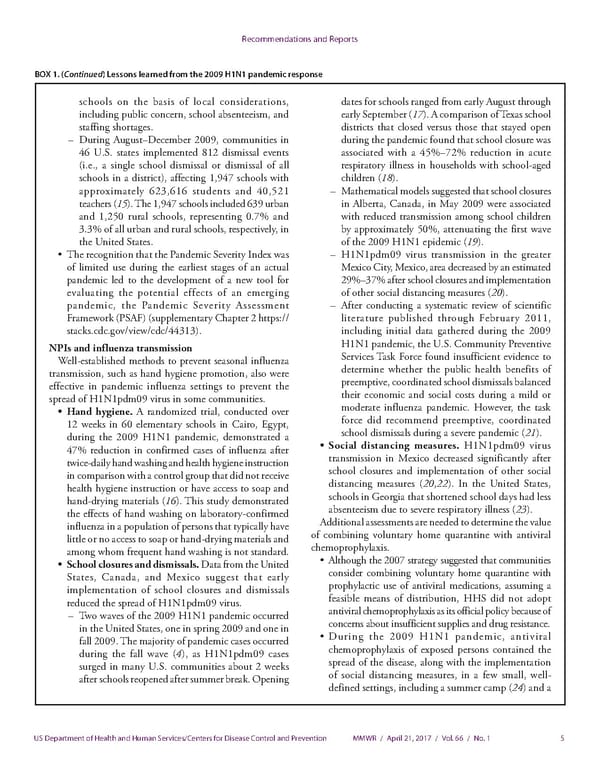Recommendations and Reports BOX 1. (Continued) Lessons learned from the 2009 H1N1 pandemic response schools on the basis of local considerations, dates for schools ranged from early August through including public concern, school absenteeism, and early September (17). A comparison of Texas school staffing shortages. districts that closed versus those that stayed open – During August–December 2009, communities in during the pandemic found that school closure was 46 U.S. states implemented 812 dismissal events associated with a 45%–72% reduction in acute (i.e., a single school dismissal or dismissal of all respiratory illness in households with school-aged schools in a district), affecting 1,947 schools with children (18). approximately 623,616 students and 40,521 – Mathematical models suggested that school closures teachers (15). The 1,947 schools included 639 urban in Alberta, Canada, in May 2009 were associated and 1,250 rural schools, representing 0.7% and with reduced transmission among school children 3.3% of all urban and rural schools, respectively, in by approximately 50%, attenuating the first wave the United States. of the 2009 H1N1 epidemic (19). • The recognition that the Pandemic Severity Index was – H1N1pdm09 virus transmission in the greater of limited use during the earliest stages of an actual Mexico City, Mexico, area decreased by an estimated pandemic led to the development of a new tool for 29%–37% after school closures and implementation evaluating the potential effects of an emerging of other social distancing measures (20). pandemic, the Pandemic Severity Assessment – After conducting a systematic review of scientific Framework (PSAF) (supplementary Chapter 2 https:// literature published through February 2011, stacks.cdc.gov/view/cdc/44313). including initial data gathered during the 2009 NPIs and influenza transmission H1N1 pandemic, the U.S. Community Preventive Well-established methods to prevent seasonal influenza Services Task Force found insufficient evidence to transmission, such as hand hygiene promotion, also were determine whether the public health benefits of effective in pandemic influenza settings to prevent the preemptive, coordinated school dismissals balanced spread of H1N1pdm09 virus in some communities. their economic and social costs during a mild or • Hand hygiene. A randomized trial, conducted over moderate influenza pandemic. However, the task 12 weeks in 60 elementary schools in Cairo, Egypt, force did recommend preemptive, coordinated during the 2009 H1N1 pandemic, demonstrated a school dismissals during a severe pandemic (21). 47% reduction in confirmed cases of influenza after • Social distancing measures. H1N1pdm09 virus twice-daily hand washing and health hygiene instruction transmission in Mexico decreased significantly after in comparison with a control group that did not receive school closures and implementation of other social health hygiene instruction or have access to soap and distancing measures (20,22). In the United States, hand-drying materials (16). This study demonstrated schools in Georgia that shortened school days had less the effects of hand washing on laboratory-confirmed absenteeism due to severe respiratory illness (23). influenza in a population of persons that typically have Additional assessments are needed to determine the value little or no access to soap or hand-drying materials and of combining voluntary home quarantine with antiviral among whom frequent hand washing is not standard. chemoprophylaxis. • School closures and dismissals. Data from the United • Although the 2007 strategy suggested that communities States, Canada, and Mexico suggest that early consider combining voluntary home quarantine with implementation of school closures and dismissals prophylactic use of antiviral medications, assuming a reduced the spread of H1N1pdm09 virus. feasible means of distribution, HHS did not adopt – Two waves of the 2009 H1N1 pandemic occurred antiviral chemoprophylaxis as its official policy because of in the United States, one in spring 2009 and one in concerns about insufficient supplies and drug resistance. fall 2009. The majority of pandemic cases occurred • During the 2009 H1N1 pandemic, antiviral during the fall wave (4), as H1N1pdm09 cases chemoprophylaxis of exposed persons contained the surged in many U.S. communities about 2 weeks spread of the disease, along with the implementation after schools reopened after summer break. Opening of social distancing measures, in a few small, well- defined settings, including a summer camp (24) and a US Department of Health and Human Services/Centers for Disease Control and Prevention MMWR / April 21, 2017 / Vol. 66 / No. 1 5
 Community Mitigation Guidelines to Prevent Pandemic Influenza Page 6 Page 8
Community Mitigation Guidelines to Prevent Pandemic Influenza Page 6 Page 8